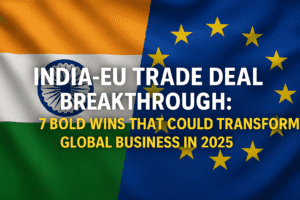India-EU Trade Deal Breakthrough: 7 Bold Wins That Could Transform Global Business in 2025
India and the EU advanced their landmark trade deal by closing two more chapters, now finalizing 7 of 23 total sections. The latest Brussels talks saw critical exchanges on market access offers for goods and services, addressing India’s priority to correct trade imbalances. Negotiators face a tight deadline, with the next round set for early September and both sides committed to a deal by year-end. Separately, India is accelerating ASEAN trade pact reviews, targeting progress by October’s summit.
While the EU clarified its carbon tax (CBAM) remains outside negotiations, these parallel efforts highlight India’s strategic push for sustainable, diversified trade partnerships amid global economic shifts. Success hinges on bridging complex gaps in the coming months.

India-EU Trade Deal Breakthrough: 7 Bold Wins That Could Transform Global Business in 2025
The latest round of India-EU Free Trade Agreement (FTA) negotiations concluded with quiet significance: two more chapters closed, bringing the total agreed chapters to 7 out of 23. While headlines focus on the count, the real story lies in the accelerating pace and the high stakes involved in crafting what could be India’s largest-ever trade pact.
The Current Pulse of Negotiations:
- Steady Progress: The 12th round in Brussels solidified agreements on new chapters (details often remain confidential until finalization) and saw crucial exchanges on services and non-services market access offers. This exchange is foundational – it defines what each side is willing to open up.
- Tight Timeline: With the next round scheduled for early September, the pressure is on. Both leaders committed to sealing the deal by year-end, making these autumn sessions critical.
- Addressing Imbalances: A core Indian objective remains front and center: rectifying perceived trade asymmetries. The deal isn’t just about volume; it’s about creating a more balanced, predictable, and sustainable trade relationship benefiting both economies.
- CBAM Clarification: EU Ambassador Hervé Delphin reiterated a crucial point: the EU’s Carbon Border Adjustment Mechanism (CBAM) is not part of these FTA talks. While impacting Indian exporters, it’s framed as a climate compliance measure separate from trade negotiations.
The ASEAN Factor: A Parallel Push
Simultaneously, India is revitalizing its trade pact with ASEAN:
- Special Secretary Rajesh Agrawal outlined plans for the 10th round (August, India) and 11th round (October, Malaysia).
- Progress is described as “chequered,” but headway is noted on customs procedures, trade facilitation, technical cooperation, and SPS/TBT standards – the often-unseen plumbing of trade that significantly impacts ease of doing business.
- The ambitious goal? Concluding the ASEAN review around the ASEAN-India Summit in late October, demonstrating India’s broader regional trade strategy.
Why This Matters for Real People and Businesses:
- Beyond Tariffs: While reducing duties is key, modern FTAs like this delve deeper. Success hinges on agreements covering services (like IT, finance, mobility), investment rules, intellectual property, sustainable development, and digital trade. These shape the future business environment.
- Economic Opportunity: For India, securing better access for its skilled professionals and services in the vast EU market is paramount. For the EU, India’s growing consumer base and manufacturing potential are major draws. A good deal can spur job creation, innovation, and consumer choice on both sides.
- Strategic Positioning: In an era of shifting global supply chains and geopolitical tensions, a strong India-EU economic partnership offers diversification and resilience for both blocs, countering over-reliance on single regions.
- The “Chequered Progress” Reality: Agrawal’s candid remark about ASEAN talks applies broadly. Trade deals are complex marathons, not sprints. Overcoming entrenched interests and regulatory differences takes persistent negotiation. The current momentum is positive, but concluding meaningful deals by year-end remains a formidable challenge requiring significant political will.
The Road Ahead: High Stakes in the Coming Months
The September EU round and the October ASEAN summit are pivotal milestones. The “7 out of 23” headline signifies tangible movement, but the true measure of success will be the quality of the agreements reached in the remaining chapters – particularly on market access, services, and investment.
The ambition is clear: landmark deals by year-end. The world is watching to see if the negotiators can bridge the gaps, delivering agreements that move beyond mere headlines to foster genuine economic partnership and shared prosperity. The coming rounds will test whether ambition can translate into concrete, balanced outcomes.
You must be logged in to post a comment.